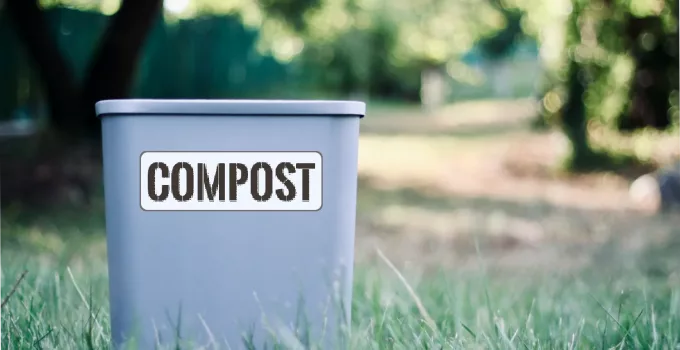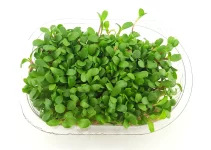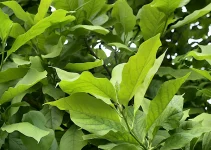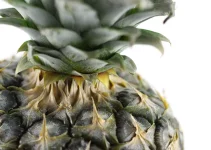Making your own organic matter is just amazing and the best compost bins and composters will be absolutely helpful for that.
If you want to improve soil quality, increase crop yields, and reduce the amount of waste you throw away by as much as 30% then you should make your own compost.
Compost can be used as mulch or combined with potting soil and can be sprinkled over grass as lawn conditioner.
Table of Contents
Best Compost Bins & Composters: My Top 5 Recommendations
I will review both the best compost bins and some small composters.
Maybe some of you will prefer the option of buying a unit where you can actually turn waste into compost (composter), not just a simple storage unit for a few days’ waste (compost bin).
1. Epica Stainless Steel Compost Bin 1.3-Gallon – Top Choice
If you’re searching for the best compost bin that will just hold your food waste until you transfer it to the compost heap then, you should check out this unit from Epica.
This Epica model is incredibly popular and also my top recommendation. First of all, the price is one of the most affordable, given its quality.
At 1.3 gallon, 11 inches in height, and 7.16 inches in diameter is fits perfectly the definition for the best compost bin.
It’s made of stainless steel and, if you change the filters, it will last a lifetime. I’m not the biggest fan of the overall design. It’s pretty classic, nothing outstanding.
It might not be shockingly pretty but it doesn’t leak, which is what we are looking for when dealing with food scraps. We don’t want a smelly liquid all over our kitchen because of a faulty bin that leaks.
It fits on countertops without taking up too much space.
But the most important aspect is the activated charcoal filter for an odorless indoor compost bin. The filter is replaceable. You should consider changing it once every 6 months.
Just don’t forget about changing the filters and wash it quite regularly. This bin will house your waste, after all. It’s not self-cleaning.
If you want to avoid washing it too often, use bags.
2. OXO Good Grips Easy-Clean Compost Bin 1.75-Gallon
If we compare this Oxo with the above Epica, then the first thing you’ll notice is that this one is a bit pricier.
This is the new and improved bigger version at 1.75 gallons, which can be nice if you have a larger family with lots of food scraps to add to your compost heap.
Although the smaller option, the one on white, looks so much better.
The best way to describe this 1.75 gallons OXO compost bin is: a very nicely designed bucket with a well-thought lid and some extra features.
Oxo claims that they have a unique design that keeps the bags tucked inside for a neat look. It’s definitely a nice touch since this bin will most like sit on the countertop.
It’s also odor-containing and pest-reducing. That’s thanks to the soft-close lid that allows oxygen to flow through. The lid is also removable for stress-free emptying.
Plus, the lid is easy to operate, you can lift it up with just one finger.
3. IM4000 Dual Chamber Tumbling Composter – Best Composter
The IM4000 is really one of the best composters to buy. It’s not even that big.
This tumbling composter has a 37 gallons capacity. You can make a decent quantity of compost without running out of space faster than the materials are turned into compost. That’s something that can definitely happen with under 20-gallon tumblers.
To better understand if it would fit in your garden/patio, this tumbler measures 28 x 36 x 30 inches and it weighs 28 pounds.
Users love it for its dual bin design, it’s definitely efficient.
It’s also solid, nothing flimsy about it and it will last a long time, as it should.
Regarding cons, there were complaints about the sliding door getting completely stuck in the winter.
Other users consider it too small for proper composting. If you think that you would be of the same opinion and you have the space, it’s best to research compost heaps, those can get very big.
But, for the price, size, overall quality and convenience that it offers, I would say that the IM4000 qualifies as a best composter without any doubt.
4. Squeeze Master Outdoor Tumbler Compost Bin
If you need a bigger size for pretty much the same money as the above model, there’s this Squeeze Master Outdoor Tumbler as a potential best composter for you.
It has a 43 gallon capacity, also dual-chambered.
Its dimensions are 28.5 x 26 x 37 inches and it weighs 26.2 pounds.
While some consider that the assembly is easy and can be done in half an hour, others think it’s not as straightforward. Others even go as far as saying that it’s impossible to put together. There are mixed reviews in this regard.
The consensus is that it’s sturdy but maybe not quite large enough to get decent composting.
5. Vitamix FoodCycler FC-50 – the Automated Way
This thing should be in a category dedicated solely to the Vitamix FoodCycler FC-50. Let’s see why I’m saying that.
First of all, it has the price of at least 4 best composters like the ones I reviewed above. Although, it’s really tiny. It’s only for indoor use.
Second of all, this thing is an automated composter.
It makes fertilizer from food scraps in mere hours (4-8 hours) all on its own. Well, you have to press a button. Oh, the hardship.
The good news is that it’s not noisy at all.
It takes the ingredients through the drying and grinding process to make very dried out finely cut food scraps.
In order to make compost from it, combine 1 cup of food scraps as produced by the FoodCycler and mix it up with 10 cups of soil. Let it sit together for 7-10 days and then you can use it in combination with potting soil or spread the compost out in the garden.
It has a couple carbon filters to prevent any odor from leaking out. The filters are not cheap so, add that to the additional cost. You can also replace the bucket.
It’s incredibly small. The Vitamix FoodCycler has a bucket with a 2L capacity (almost 0.53 gallons). That’s absolutely small, you’ll have to use it often. The bucket is dishwasher safe.
It works for almost all food waste, including chicken bones.
I debated whether to include the Vitamix FoodCycler FC-50 in my post on the best compost bins and best composters but I really wanted to inform you about it.
Even if we can’t afford it or find it outrageous, it’s still nice to talk about it, just to see what manufacturers come up with.
Would I pay hundreds of dollars on it? Of course not, I have bills to pay first. But I enjoyed writing a bit about it.
Compost Bin vs Composter
I just want to make something clear right from the start, before going into my reviews for the best compost bins and composters.
So, we have a compost bin and a composter. If we’re going technically, there’s definitely a difference between the two.
A compost bin is the term used to refer to a place where you store your food waste until your carry it to the compost heap or to the composter.
The composter or the compost heap is the place where the actual compost is made.
You can’t make compost in a compost bin/
A compost bin is basically a caddy that can have some filters to prevent the food waste to make your house smell.
Think of them as a nicely designed pot with a lid, with a few additional features. It allows you to gather a few days of waste until you take them on the patio or in the garden where your composter/compost heap is placed.
How to Choose the Best Compost Bins/Composters

You don’t actually need to know much in order to find the best compost bin for your household.
If you don’t actually want to buy a composter, I talk about some DIY options later on in this article.
Size
There’s quite the variety even when it comes to choosing the best compost bins based on their size.
This is the primary factor that you will influence your choice. You need to know the size of the space where you plan to place the bin. Knowing that will define your options and make the selection process much easier.
A 1.3 gallons is pretty standard and a good size.
2.3 gallons is already considered pretty big for a compost bin.
The best small composters have a size from about 18 gallons to about 43 gallons. All the options that I reviewed above can fit on a small patio or in a very small garden. That’s their major advantage.
Types
Most compost bins will fit perfectly well on the countertop. These models are are some of the most popular when it comes to choosing the best compost bins and composters.
There are also mountable models, which fit perfectly in a kitchen with not much available space anywhere.
Tumbling composters are perfect for outdoor use and they’re the ones where the actual compost can be made from start to finish.
Wooden composters are another option, especially if you choose to make a DIY composter. The beauty is that you can make it as big as you want.
Materials
The large majority are either made from metal or plastic. Wood is a third option but it’s less frequent.
Wood is definitely a popular option if you’re building your own compost system in the garden.
Price
First of all, just because the word small is included to characterize these particular compost bins that I reviewed above, that doesn’t mean that all of them are exactly affordable.
Some truly are quite cheap but others not so much. Take your budget into consideration when going shopping because there are plenty of options to match everyone’s needs.
With $20 you can buy some of the best compost bins, which is not bad at all. They’re only made to hold the food waste until you carry it to the compost heap so, they really shouldn’t cost much.
On the other hand,
Even the most affordable small composters can cost 4-5 times as much as a bin but the price is justifiable. After all, you can actually compost in composters.
When shopping for the best composters, be prepared to spend a bit of money but be reassured that this is indeed one of the best investments that you can make.
Plus, they should last forever.
How to Use Composters
Stirring the compost materials regularly is crucial. Actually, every time you add new waste, it’s best to stir the entire composition all over again.
You definitely need a stick or a shovel or any other tool that you can think of for stirring.
The exception to needing a tool for stirring is made by tumbling composters, those just need to be rotated. They’re more hassle-free in this respect.
If tumblers get very heavy, they will be more difficult to rotate. Choosing a smaller size might be the best option for a beginner.
Unfortunately, tumblers are quite expensive.
Best Composters Alternatives
Shopping for the best compost bins is not the only option when it comes to having compost for your soil. There are quite a few compost bins alternatives.
Buy compost
Actually, the simplest alternative to making your own compost in a DIY/bought composter is to buy the compost directly.
It definitely works if you only need it for houseplants or for a small garden. In both these situations the cost will not deplete your budget.
Buying something already made and ready to be used is something a lot of us prefer to do. But it’s not a good alternative for those who actually want to reduce the amount of things they simply throw away.
Create a compost heap
The concept of creating a heap to make compost is very appealing because it doesn’t involve a big cost. A lot of people love this approach.
The first thing that you should know is that the container that you choose for the compost heap shouldn’t have a bottom. The compost heap will directly touch the ground.
You can use wooden planks to build a structure, check out the New Zealand box compost system, it’s quite good.
A very basic compost bin can also be made from stout wire mesh shaped into a cylinder and lined with old carpet.
Or just make a compost heap directly on the ground and cover it with an old carpet or tarpaulin to protect it from rain.
Place your compost heap in the shade.
Trench composting
The second alternative to buying the best compost bins and composters is to do trench composting, which is only possible as long as you live in a house with plenty of space for an outdoor garden.
Trench composting is exactly what it sounds. You just have to dig a hole about a foot deep and wide and fill it with kitchen scraps (vegetable waste, fruit scraps, coffee grounds), grass clippings, dead leaves, branches, twigs, and biodegradable materials (cardboard boxes, newspapers).
Once the hole is filled with all these ingredients, you can put the dirt back on top.
Don’t grow your plants right above the trench compost. Plant them adjacent to the composting spot.
DIY composter
This DIY solution for a composter is very cheap and easy to make. You should definitely check it out. This website has the perfect compost bin alternative.
Furthermore, this DIY compost bin will only works if you can place it outside in the garden because it has small holes at the bottom. Liquid will seep out of the bin so, it can’t go in the kitchen or on the countertop.
This kind of composter should be placed directly on the ground so everything that leaks will go directly into the soil.
This is how you make your own compost bin:
- you need a plastic bin with a tight fitting lid (24 inches tall or taller) – the lid is needed to keep moisture in and pests out
- drill 8-10 small holes at the bottom of the bin
- for air flow, make the same 8-10 small holes in the lid, too
- place it in a shady area, being placed in full sun will make the compost dry out
That’s basically all the preparation you need to make a DIY compost bin. It’s definitely easy.
Now, you need to make the compost and the authors of that website guide the readers in that.
How to make the compost:
- shredded newspaper or dry leaves are the first layer at the bottom of the bin – fill it about 1/8 – 1/4 full
- place dirt (garden soil) on top of that until the bin is half full
- now, you can add food scraps or paper products (you can collect your food scraps in an airtight container) – it can make you eat more fruits and vegetables just so you can have waste to add to your DIY compost bin, which is an unexpected pro for making your own compost
- stir the compost with a shovel or stick, making sure to cover the added food scraps with dirt
- spray with lukewarm water until moist – don’t make it soggy, it can start to smell if you add too much water
- it’s best to mix it every time you add new waste and to make sure that it’s covered by dirt, it will also help break down everything faster
- it can be ready for use in the garden or in pots in about 2 to 3 months
Why Composting is Awesome
The main organic materials are compost, plant residues or manure.
Organic matter is extremely important because it’s a reservoir of nutrients and water in the soil. Moreover, it also prevents surface crusting. Plus, it’s a helpful addition to sandy soils, increasing their water retention capacity. It increases water infiltration into the soil.
Compost is the one out of those three that we can make at home simply from our waste and a bit of extra ingredients.
Compost results from the natural breakdown of organic materials when mixed with oxygen. The result is a stable, soil-like material.
So, on top of redirecting some of your waste instead of simply throwing it in the bin, you also end up making an amazing product for plants. It doesn’t matter whether you have houseplants or you want to enrich your garden soil, compost works in both situations.
Compost vs Fertilizer
Composting creates the perfect mixture of organic materials for a soil that’s ready to offer plants every nutrient they need for growing healthy. It also increases water retention and decreases runoff.
The main difference between compost and fertilizer is that the former is for feeding the soil and the latter is for feeding the plants. Fertilizer can also be called plant food but, as I mentioned just above, organic matter has a complex role when added to soil.
Compost can, to a certain extent, serve as a substitute for fertilizer because it contains nitrogen, phosphate and potassium plus plant micro-nutrients (magnesium and sulfur).
Some people prefer it to chemical fertilizers.
Well, the only people who aren’t interested in it are those growing plants hydroponically or in an aquaponics system.
What You Can Compost
There are 4 main components to composting:
- nitrogen (from food waste)
- carbon (from the yard, cardboard boxes, paper, newspapers)
- moisture (water)
- air
Nitrogen is provided by green materials, while carbon is provided by brown materials.
Brown materials also contain the needed air for composting to work, provide structure, and absorb the liquids that occur during breakdown.
Wood shavings provide great air pockets, they should be at the top of your list for brown materials.
The aim is to achieve a 50/50 mix of green and brown materials.
Green materials
- fruit and vegetable peelings
- coffee grounds – a top ingredient to add, has a wide range of microorganisms and a microporous structure, you might think they’re acidic but they’re actually not and they’re a great source of nitrogen
- plants, plant cuttings, including weeds, dry leaves, grass clippings, twigs, hay
- egg shells
- tea bags and leaves
- leftover pulp from juicing
- seaweed – can be used dry & wet, a material to consider because it’s a rich source of trace elements, rich in potassium and nitrogen
- stale bread if you’re not turning it into breadcrumbs
Brown materials
- wood shavings, wood chippings, saw dust
- nuts and shells, peanut shells (no walnuts)
- cardboard boxes, shredded newspapers, shredded egg cartons, tissues, paper towels, napkins, brown bags
- dry plant stems
What You Can’t Compost
- animal droppings (dog and cat poo)
- vegetables cooked in oils because oil slows down the decomposition process
- citrus fruits are too acidic
- meats, bones, dairy, oil, fat, grease and cooked food – the exception is if you’re using hot bins, in that case you can transform even cooked food into compost
- diseased plants
- colored paper
- non-biodegradable materials
- toxic materials
Making compost is not an exact science so, don’t treat it like one. You can just approximate how much green materials and brown material make up your heap.
And if you find that the best compost bins or the best composters aren’t worth the price, I presented you with some much cheaper options but I’m sure that you can find even more alternatives if you look for them.




